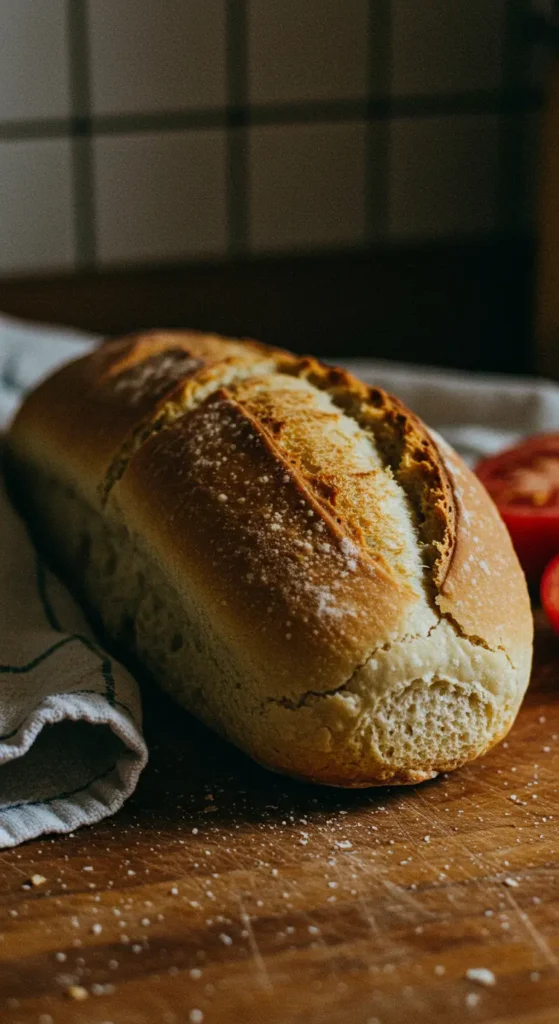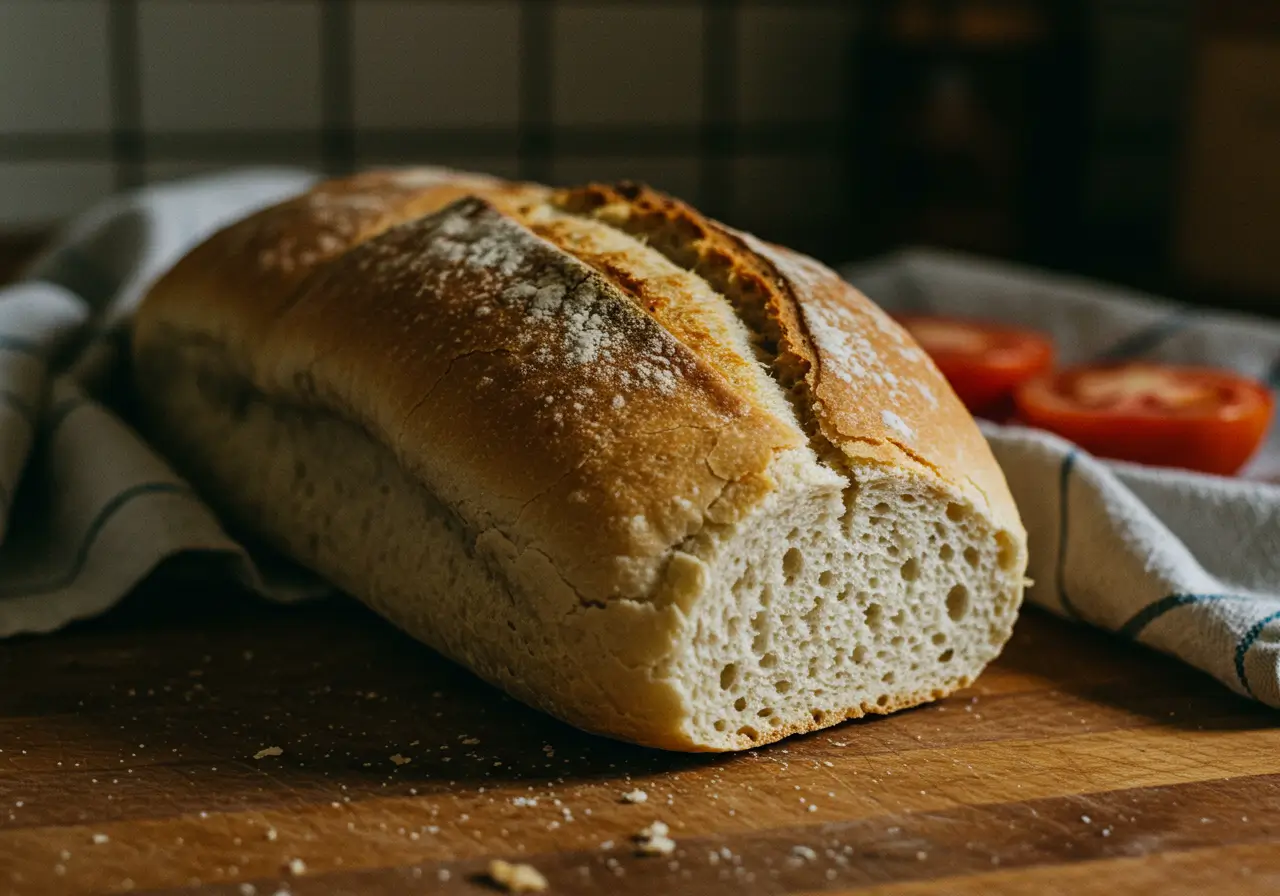Crusty Italian Bread
Table of Contents
Few things spark joy like the scent of freshly baked crusty Italian bread wafting through your kitchen. With its crackling golden crust and airy, chewy center, this rustic loaf isn’t just food—it’s an experience. Whether you’re serving it with a steamy bowl of soup, building the perfect bruschetta, or simply enjoying it warm with a drizzle of olive oil, this bread has a way of stealing the spotlight.
In this article, we’re diving deep into the soul of Italian rustic bread. You’ll learn everything from its heritage and irresistible texture to how to bake it at home like a pro—even without a fancy oven or years of baking under your apron. We’ll explore essential tools, common mistakes, delicious pairings, and even tips to keep your loaf ultra crispy.
Ready to unlock the secrets behind the perfect crusty loaf? Let’s jump in.
Key Ingredients that Define Crusty Italian Bread

The Basics: Flour, Water, Yeast, Salt
At its heart, crusty Italian bread is proof that less is more. You don’t need a dozen fancy ingredients—just four pantry staples. First, there’s all-purpose flour or sometimes bread flour, which gives the dough its structure. Then comes water, which hydrates and activates the yeast.
Speaking of yeast, a tiny spoonful of instant dry yeast or active dry yeast goes a long way. It’s the powerhouse behind that airy rise. And finally, sea salt—not just for flavor, but for balance. Without it, the bread would taste flat and rise too fast.
Simple, right? But when you mix them just right and give them time to work their magic, you’re on your way to one truly unforgettable loaf.
Traditional Enhancements: Olive Oil, Herbs, and Semolina
Want to jazz things up a bit? Italians often add their own spin with ingredients like extra virgin olive oil for richness or fresh rosemary for an earthy aroma. Some regional loaves even include semolina flour for a slightly nutty flavor and a golden crust that’s hard to resist.
Others sprinkle cornmeal or semolina on the baking surface to prevent sticking and boost that crisp bite. While the basics remain unchanged, these traditional touches keep every loaf unique—and oh-so memorable.
The Art and Science of Making Crusty Italian Bread

No-Knead and No-Fuss: The Rise of Simplicity
Believe it or not, making crusty Italian bread at home doesn’t require years of baking wisdom or a cupboard full of gadgets. In fact, the most magical loaves come from the simplest methods—hello, no-knead bread! By mixing the ingredients and letting time do the work, the dough develops flavor and structure all on its own.
Once you stir everything together, cover it, and let it rest for a couple of hours, you’ll find it doubles in size and becomes wonderfully stretchy. This is where the magic begins. And the best part? No messy kneading. Just a gentle fold and shape before baking is all it takes.
This method isn’t just beginner-friendly—it’s fail-proof. Even if you’re just dipping your toes into the world of homemade artisan bread, you’ll get results that look and taste straight out of a Tuscan bakery.
Baking with Steam: How to Achieve That Signature Crust
So what gives crusty Italian bread its signature crunch? Steam, my friend—lots of it. When the dough hits a hot oven, steam surrounds the loaf, keeping the crust soft while the inside expands. Then, as the moisture evaporates, it leaves behind that irresistibly crisp crust.
There are a couple of ways to create steam. You can place an oven-safe dish filled with water on the bottom rack or—if you’re using a Dutch oven—simply trap the steam inside during the first phase of baking. Either method works wonders.
If you’re curious about another fun, homemade bread recipe that doesn’t skimp on texture, check out these delightful Homemade Soft Pretzels. They’re chewy, golden, and totally addictive.
Popular Variations Across Italy
From Tuscan Pane Sciocco to Sicilian Mafalda
Travel across Italy and you’ll find that every region boasts its own version of crusty bread. Take pane sciocco, for example—a salt-free Tuscan loaf that lets olive oil and prosciutto take the flavor spotlight. It’s a perfect match for salty toppings and hearty stews.
Head further south and you’ll stumble upon Mafalda, a sesame-crusted bread from Sicily with a soft interior and a twisty, coiled shape. Its golden crust and nutty topping make it a standout at any meal.
Each style has its charm, but all share that unmistakable rustic feel and deep connection to tradition.
Regional Twists: Hard vs. Soft Crusts
While northern Italian breads tend to be heartier with tough, chewy crusts (ideal for long winters and thick soups), southern styles often lean lighter and airier. Think crusty but not too hard—just enough bite to satisfy.
In Liguria, for instance, you’ll find loaves enriched with olive oil, which lends a softer crust and rich flavor. Meanwhile, in Rome, bakers go bold with long fermentations that result in an ultra crusty, deeply browned loaf.
These variations highlight how geography, ingredients, and history shape even the most basic foods—turning simple crusty Italian bread into a culinary passport across the country.
Equipment Essentials for Perfect Results
Dutch Oven vs. Pizza Stone: Which to Choose?
If you’re aiming for that signature crusty Italian bread crunch, the right equipment can make all the difference. A Dutch oven is a favorite among home bakers. Why? Because it traps steam inside, mimicking a professional bread oven. This creates that golden, shatteringly crisp crust we all dream about.
On the flip side, a pizza stone offers a more traditional baking surface. It preheats in the oven and delivers strong bottom heat, giving the loaf an even bake and beautifully browned base. Just don’t forget to add steam to your oven when using it!
Both tools work great, so it really comes down to what’s already in your kitchen—or what you’re willing to invest in for perfect bread at home.
Must-Have Tools: Lame, Banneton, and Peel
Beyond baking vessels, a few other tools can level up your baking game. A bread lame helps you score the dough cleanly, letting it expand without bursting. A banneton basket supports your loaf during its final rise, helping it hold shape and develop that lovely spiral look.
And if you’re using a pizza stone, a pizza peel makes transferring the dough super easy—no burns or awkward flips required. With these simple tools, you’ll feel like a pro baker in no time.
Serving Ideas & Pairings
Soups, Bruschetta, and Sandwiches—What Goes Best
One of the best things about crusty Italian bread? It’s endlessly versatile. Whether you’re planning a fancy dinner or a casual lunch, this rustic loaf rises to the occasion.
First off, it’s a soup’s best friend. That crisp exterior holds up beautifully when dipped into hearty dishes like French onion soup, minestrone, or tomato basil bisque. No soggy bites here—just pure, satisfying texture.
Then there’s bruschetta. A toasted slice topped with garlic, ripe tomatoes, fresh basil, and olive oil is a match made in Mediterranean heaven. And for sandwiches? Think panini with melty mozzarella, prosciutto, and arugula. Yum.
Wine, Olive Oil & Cheese: Classic Companions
Let’s not forget the simple joys. A slice of crusty Italian bread with a drizzle of extra virgin olive oil, maybe a sprinkle of sea salt, and a chunk of sharp pecorino—perfection.
Pair it with a light Italian red wine like Chianti or Barbera, and you’ve got yourself a rustic appetizer or cozy evening snack. These flavors all play well together, creating a bite that’s both comforting and refined.
Crusty artisan bread really shines when it’s part of a shared table. So gather your favorite flavors, pour a little wine, and enjoy it the Italian way—slowly and with good company.
Troubleshooting & Tips for Success
Why Your Bread Isn’t Rising Enough
So, your crusty Italian bread turned out a little… flat? Don’t worry—it happens to the best of us. The most common culprit is inactive yeast. Always check the date on your yeast packet, and make sure your water isn’t too hot (or too cold) when mixing. Lukewarm is the sweet spot.
Sometimes, it’s just about giving the dough more time. If your kitchen is cold, the dough might need a little longer to rise. So, be patient—it’s worth the wait!
How to Keep That Crust Crispy
You nailed the bake, but a few hours later the crust goes soft? It’s a common issue. The key is cooling. Let your bread cool completely on a wire rack so the steam can escape. This keeps the bottom from getting soggy and helps the crust stay crispy.
Also, avoid storing bread in plastic. Instead, wrap it in a clean kitchen towel or keep it in a paper bag to preserve that perfect crunch.
Print
Crusty Italian Bread
- Total Time: PT45M
- Yield: Serves 8
- Diet: Vegan
Description
This crusty Italian bread recipe is an easy, no-knead, rustic loaf with a golden crunchy crust and soft, airy inside. Made with just four basic ingredients and no fancy tools, it’s perfect for dipping, sandwich-making, or pairing with soups and olive oil. It brings the comforting, old-world taste of Italy into your kitchen with minimal effort.
Ingredients
- 3 1/4 cups all-purpose flour (plus more for dusting)
- 1 tsp sea salt
- 1.5 cups warm water
- 2 tsp instant yeast (or active dry yeast)
- Semolina or cornmeal (for dusting, optional)
Instructions
- In a large bowl, mix the flour, salt, and yeast until combined.
- Add the warm water and stir until a sticky dough forms. No kneading needed.
- Cover the bowl with plastic wrap and a towel. Let it rise for 2–3 hours until doubled in size.
- Flour a surface and gently shape the dough into a round loaf. Avoid kneading.
- Score the top of the dough with a sharp knife.
- Let it rest on parchment or a pizza peel while the oven preheats.
- Preheat the oven to 450°F (232°C) with a pizza stone or Dutch oven inside. Add a dish of water for steam.
- Carefully place the dough into the hot oven and bake for 30–45 minutes until golden brown and crisp.
- Cool on a wire rack before slicing to maintain the crust.
Notes
- Let the bread cool fully to keep the crust crispy.
- Store in a paper bag or wrap in a kitchen towel—avoid plastic.
- For extra crispiness, cool it in the oven with the door slightly open.
- Use a Dutch oven for a guaranteed crispy crust without needing extra steam.
- Prep Time: PT5M
- Cook Time: PT40M
- Category: Bread
- Method: Baking
- Cuisine: Italian
Nutrition
- Serving Size: 1 slice
- Calories: 195
- Sugar: 1g
- Sodium: 295mg
- Fat: 1g
- Saturated Fat: 0g
- Unsaturated Fat: 1g
- Trans Fat: 0g
- Carbohydrates: 40g
- Fiber: 2g
- Protein: 6g
- Cholesterol: 0mg
Keywords: crusty Italian bread, rustic bread, artisan bread, homemade bread, no-knead bread, Italian loaf, vegan bread
FAQs About Crusty Italian Bread
What’s the difference between Italian bread and French bread?
While both have delicious crusts, crusty Italian bread usually contains olive oil, which gives it a richer flavor and a slightly softer texture inside. French bread, like baguettes, tends to be leaner and crustier all around.
Can I freeze crusty bread without losing the crunch?
Absolutely! Wrap it tightly in foil, then place it in a freezer bag. When you’re ready to eat it, reheat the loaf in the oven at 350°F for 10–15 minutes. It brings the crunch right back—like magic.
Is a pizza oven necessary for an authentic bake?
Not at all. While a pizza oven can create that blistered crust and smoky flavor, your regular oven works just fine. Just use a pizza stone or Dutch oven and remember to add steam. It’s the steam that gives crusty Italian bread its signature crackle.

